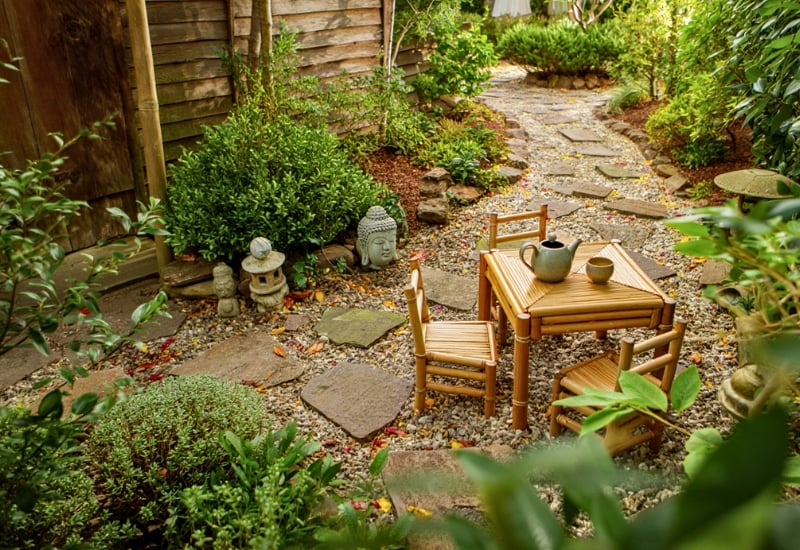You don’t stumble into a Zen garden. You sort of arrive—a little quieter, a little more aware, like your thoughts finally sat down for a cup of tea.
There’s no grand entrance. No “ta-da” moment. Just a soft invitation to pause. A ripple in a stone basin. A fern nodding in the breeze. The hush of raked gravel in neat, meditative lines. These gardens aren’t trying to impress you—they’re trying to unwind you.
And they’re sneaky, too. What looks like simplicity is actually a quiet genius at work. Every stone, every leaf, every bit of empty space is exactly where it needs to be. Nothing extra, nothing loud—and somehow, everything feels complete.
I’ve always loved how Zen gardens seem to breathe with you. They don’t ask for maintenance as much as mindfulness. A little pruning here, a little sweeping there. And in return? A little peace. A little stillness.
But here’s the best part: You don’t need a monastery or acres of land. These 26 small Zen garden ideas are made for real spaces—urban balconies, awkward side yards, narrow walkways that no one knows what to do with. And yet, they hold that same calm.
Some are modern. Some lean wild. A few might make you look twice. But all of them? They’re rooted in one simple idea: make space for peace. Let’s take a step in. Barefoot, if you like.
1. Whispering Bamboo Walk
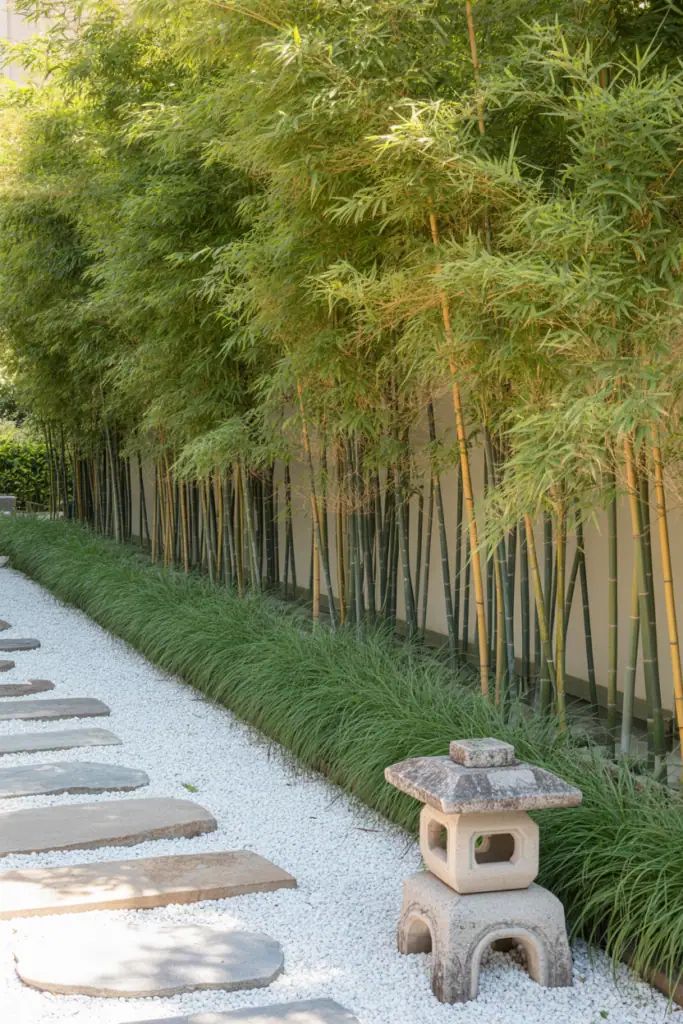
A narrow footprint doesn’t limit serenity—this garden shows how vertical layering can create privacy and peace in equal measure. Tall clumps of clumping bamboo (try Bambusa textilis or Fargesia robusta for non-invasive options) rise like a living curtain, filtering light and rustling gently with each breeze. Beneath, a band of fine-textured ornamental grass—such as dwarf mondo grass or Liriope muscari—softens the transition from stem to ground. The crisp line of low green tuft meets a ribbon of white gravel, which amplifies light and creates visual calm. Use crushed limestone or marble chips for that pristine surface. Stepping stones, irregular but purposefully spaced, invite mindful movement along the path. A simple lantern anchor—stone or concrete—adds just enough formality without clutter. If recreating this look, focus on three vertical planes: tall, airy backdrop (bamboo), a soft mid-layer (grass), and clean gravel foreground. It’s restraint that radiates.
2. Stone Guardians Under Camellias
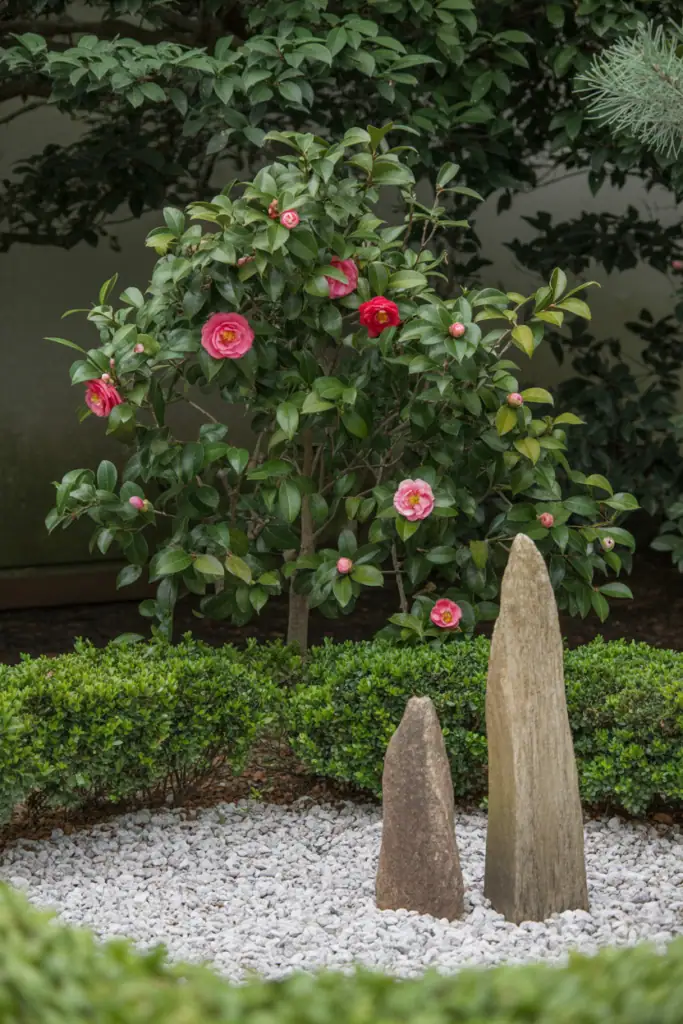
This Zen-inspired vignette invites quiet reflection through sculptural restraint and seasonal bloom. Centered around upright standing stones—weathered, irregular, but perfectly placed—this scene builds harmony between permanence and softness. At the backdrop, a mature Camellia japonica offers glossy evergreen foliage and velvety rose-like blooms. Groundcover boxwood (Buxus microphylla ‘Green Beauty’) adds a crisp living border that feels architectural yet organic. Crushed lava rock or white pumice gravel surrounds the stones, enhancing the play of shadows and giving visual weight to the arrangement. To adapt this look, focus on proportions and spacing. Let the stones speak, not shout—choose two or three with varied height and form. Surround with evergreen backbone plants and a single seasonal bloomer for subtle drama. This garden doesn’t clamor for attention—it rewards stillness.
3. Maple and Moss Island

This composition captures the Zen of contrast—where every element serves a role in balance. A single Japanese maple (Acer palmatum ‘Bloodgood’ or ‘Shaina’) rises delicately from a bed of thick moss, its burgundy foliage hovering like a canopy of lace. The round planter is framed with stacked blocks—weathered concrete or stone pavers work well—creating a visual “island” in a raked gravel sea. Surrounding the island, concentric circles of combed gravel echo ripples in water, reinforcing the meditative mood. Moss is key here—use cushion moss or Hypnum if available, and keep it moist and shaded. The tree’s fine branches contrast beautifully with the smooth stone and soft moss. If you’re building your own, start with the center and build outward—define the boundary with stacked materials, mound your moss with care, and select a slow-growing maple that casts delicate shadows across the whole space.
4. Yin Yang Herb Spiral

Herbs meet harmony in this sculpted oasis where form is as vital as fragrance. Designed in a soft yin-yang sweep, this garden uses fine gravel as a canvas and native stone as gentle punctuation. The beds brim with textural contrast—soft thyme, upright rosemary, velvety oregano, and the silvery shimmer of variegated sage. Each cluster is chosen not just for culinary use but for shape and scent—this is a garden you interact with through touch and breath. To recreate, select three to five herbs with varied heights and foliage tones, and lay them in a spiral or figure-eight bed edged with river stones or limestone chunks. The surrounding gravel can be quartzite, decomposed granite, or even sand—raked daily or weekly into flowing waves to reset the space. This design is both meditative and practical—proof that beauty and utility can thrive together.
5. Narrow Zen Passage

Even the tightest corridor can become a sanctuary when the elements are right. This narrow passageway uses pale raked gravel, natural stepping stones, and sculptural plantings to create a space that feels contemplative rather than cramped. The rich contrast between the light ground and dark vertical siding adds drama, while moss islands and a Japanese maple provide grounding texture and seasonal color. To recreate this look, choose crushed granite or white gravel as a base, and add only what’s essential: one focal tree (Acer palmatum is ideal), a few mounds of moss or fern, and large stepping stones with generous breathing room. Use black-painted fencing or walls to heighten contrast and contain the eye. This garden proves that even transition spaces can offer transformation.
6. Sacred Bloom Circle

This design blends exuberance and stillness—a centered Buddha statue grounds the space while layered perennials bring seasonal rhythm. Start by building a circular plinth using stacked natural stone or slate, then top it with mounded moss and creeping thyme (Thymus serpyllum or woolly thyme are great options). The radial planting pattern draws the eye inward, while paving stones laid loosely in crushed gravel allow for gentle wandering. Surround the core with vibrant color: foxgloves, daisies, salvia, and echinacea echo classic cottage gardens while still holding a sense of wild grace. For structure, include low hedging—boxwood or dwarf myrtle—and allow room for volunteers and reseeders. What makes this garden sing is its contrast: stillness at the heart, motion at the edges. To recreate, anchor the middle first, then build out with drifts of color and texture like brushstrokes on a circular canvas.
7. Dappled Light Fern Walk
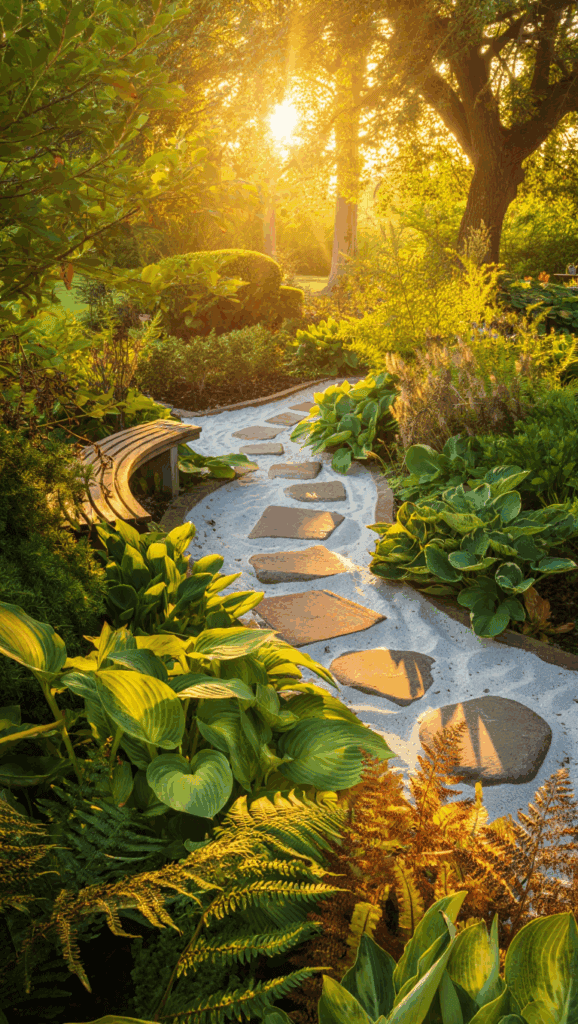
There’s a quiet kind of luxury that only filtered sunlight can provide, and this shady garden captures it perfectly. A winding path—made with irregular stone slabs nestled into crushed granite—draws you deeper beneath tall trees and thick plantings. It’s flanked by overlapping textures of hostas, ferns, and woodland perennials. Hosta ‘June’ or ‘Patriot’ offer broad, elegant foliage, while native ferns like Dryopteris or Athyrium add vertical flutter. The trick is to let plants spill over the edge slightly—it softens the path, inviting a slower, more contemplative pace. Add a curved bench in natural wood or weathered iron for a resting point that feels earned. To recreate the mood, focus on light—choose a semi-shaded spot and plan for morning or golden-hour moments. It’s a garden that glows from within, no spotlight needed.
8. Lotus Stillness Bowl

In the smallest space, water can bring the greatest calm. This simple water bowl transforms a corner into a scene of reflection and renewal. A glazed ceramic container holds just enough depth to float a sacred lotus (Nelumbo nucifera) or hardy water lilies, while a surrounding mulch of gravel or pebbles keeps the scene grounded. Add a stone lantern or driftwood sculpture for vertical balance and a nod to tradition. If lotus feels ambitious, start with dwarf lilies like Nymphaea ‘Helvola’ and complement with floating pennywort or water hyacinth. Make sure the vessel receives at least 5–6 hours of sun and stays topped with clean, dechlorinated water. This garden element invites pause and can be scaled to any patio, balcony, or shady nook. It’s not about size—it’s about serenity.
9. Bench of Blooming Balance

Every garden needs a place to pause, and this one makes the pause the purpose. Anchored by a handcrafted wooden bench—organic in form, yet substantial—the space feels both welcoming and grounded. The crushed gravel underfoot is soft in tone, letting the colors around it sing. Azaleas and rhododendrons frame the view, their blooms like watercolor brushstrokes. Taller perennials such as hollyhocks and verbascum create height and movement, while formal stone gateposts lend a sense of entry. To recreate this design, think of balance: combine soft with bold, curved with structured. Use flowering shrubs as your foundation, then build upward and outward with spires and mounds. Whether you sit or simply admire, the bench becomes a focal point that ties the scene together—a quiet invitation in the heart of abundance.
10. Balcony Bonsai Moment

Even the smallest ledge can offer a world of calm. This intimate balcony garden layers bonsai, moss, and texture to transform a simple corner into a quiet retreat. A narrow shelf holds potted bonsai—Japanese maple, dwarf pine, and juniper—each one pruned with care to highlight movement and form. Below, soft river pebbles and pale gravel create a meditative flooring, with a touch of hand-raked sand patterns beneath. Small stacked stones and moss blocks add gentle variation. You don’t need a yard to recreate this scene—just sunlight, good drainage, and a curated collection of miniature trees. For pots, choose ceramic or unglazed clay in earth tones. Add slow-growing moss in trays or concrete blocks, and allow space to breathe between elements. This is a garden not for walking, but for observing—a space where time slows and light lingers.
11. Circle of Stillness
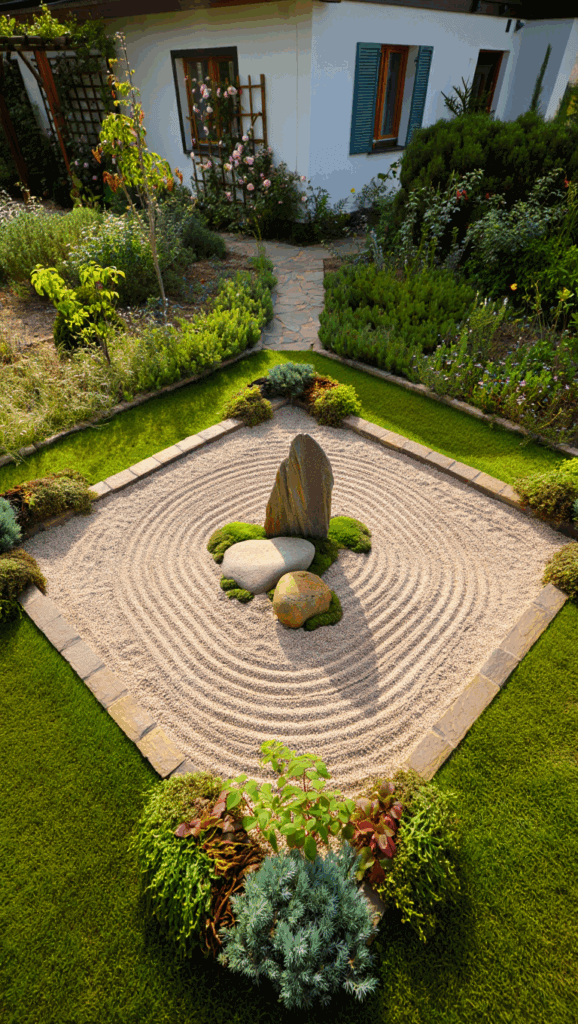
This Zen garden lives at the meeting point of geometry and tranquility. Set in a square base with a centered circular raking pattern, it frames a sculptural stone arrangement—one tall monolith flanked by rounded companions—set against tufts of moss that soften their base. Carefully selected gravel (pea gravel or decomposed granite) is raked in perfect ripples, pulling the eye inward. The border, built with uniform cut stone, offers a sense of containment that highlights the contemplative space within. Recreate this by choosing one or two vertical stones and several horizontal ones—ideally of differing textures. Moss varieties like Irish moss or Scotch moss add green contrast around the base, while evergreen shrubs at the corners ground the square in its surroundings. This garden invites daily raking, quiet mind, and visual discipline. It’s not static—it breathes through simplicity.
12. Moss Wall Fountain Nook

A soft trickle of water transforms this hidden corner into a living soundscape. Constructed from stacked slate or flat river stone, the cascading fountain mimics the feel of a forest spring. Framed by glossy-leaved tropicals—like aspidistra, ferns, and calatheas—it turns a shaded wall into a sensory oasis. The moss-covered stones, the patina on the wall, the dappled light across wet leaves—all combine to create depth and stillness. You don’t need a pump with power, just one that whispers. Try solar-powered options for sustainability and ease. If shade is abundant, emphasize foliage over flowers—use textures to build dimension. Underfoot, dark gravel keeps moisture and mood intact, with flat stepping stones offering access. This setup suits any courtyard or side yard craving movement without clutter. It’s a gentle invitation to pause.
13. Stone Bench Among the Blossoms
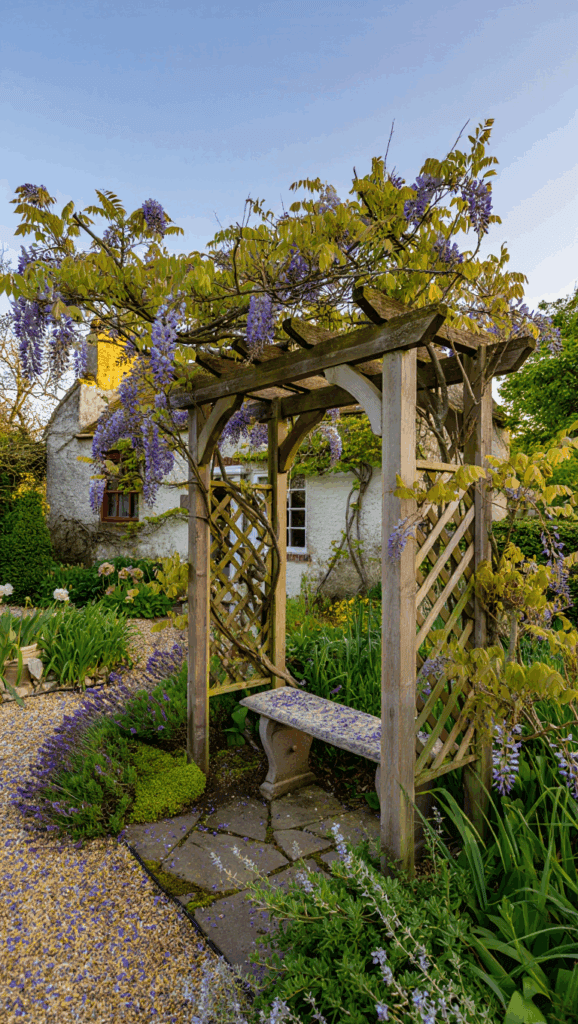
This scene balances rustic charm with timeless structure. A curved stone or cast-concrete bench rests under an arching wisteria trellis, flanked by scattered lavender and hardy groundcovers. The pathway below, made of irregular flagstone set in gravel, invites visitors to slow their pace. Around the edges, plant soft drifts of Nepeta, salvia, or creeping thyme to blur the line between built and wild. Wisteria floribunda ‘Blue Moon’ or ‘Amethyst Falls’ are perfect for temperate gardens. Keep the palette to purples and silvers for cohesion. When designing your version, choose a shady or semi-shaded area with rich soil, and focus on scent and texture. It’s a bench for morning tea or twilight reflection—simple, graceful, and grounded in bloom.
14. Dry Stream Meditation Path

A winding ribbon of slate-blue gravel mimics the flow of water in this dry stream path—a classic Zen technique for introducing movement without moisture. The curving design naturally draws the eye and guides the body, flanked by a mix of broad-leafed irises, hostas, and groundcovers. Smooth river rocks line the edge, placed deliberately to soften transitions and enhance the organic flow. To recreate this look, choose crushed slate or dark gravel for the “stream” and vary the size of your edging stones for visual rhythm. Consider Siberian irises or blue-eyed grass for vertical interest, and tuck in creeping Jenny or Ajuga to fill gaps. This path doesn’t just take you through the garden—it carries you gently from one state of mind to another.
15. Stepping Stones of Quiet Strength
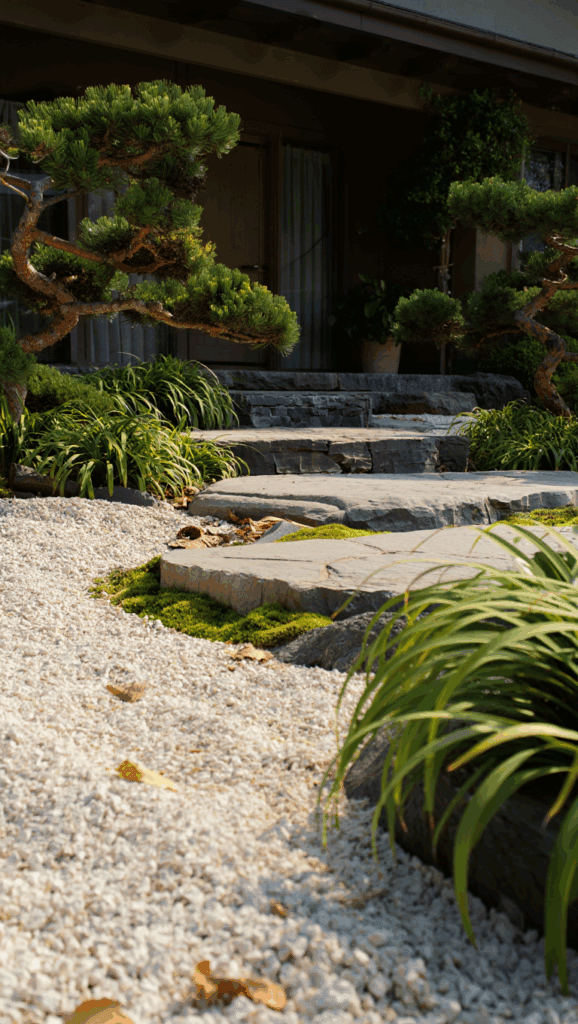
Sometimes the journey itself becomes the meditation. This elegant entry garden uses flat-cut stone slabs arranged in subtle elevation, creating a steady incline softened by moss and narrow-leaved liriope. The foundation is fine white gravel, raked between forms to emphasize spacing and stillness. Sculpted pines—trained over years—frame the scene with deliberate asymmetry. To recreate, select large, stable stones for the path and allow for space between them—don’t rush the layout. Use dwarf mondo grass or hakone grass to frame the edges and introduce life without clutter. Gravel should be pale and fine, such as crushed granite, to keep the scene reflective. This is a garden that greets you not with grandeur, but with grounding.
16. Woodland Water Mirror

This scene captures a perfect harmony between structure and softness. A moss-laced stone basin rests gently under the arched canopy of a weeping tree—try Japanese maple or weeping cherry for a similar effect. Water trickles from a rustic spout carved from natural stone or bamboo, creating subtle sound amid the shaded hush. The edge is softened with ferns, hostas, and wild violets, all thriving in the cool understory. To recreate this moment, start with a shallow concrete or carved stone bowl—weather it naturally or let moss take over. Place it under filtered shade, ideally beneath a deciduous tree for seasonal light shifts. What makes this garden sing is its invitation to look down—to watch the sky reflected in still water, reminding us of what lies above and below.
17. Buddha Pathway to Tea

This design is a quiet invitation to slow down. A winding flagstone path meanders through lush, low-growing groundcovers—creeping thyme, dwarf mondo grass, and fine-textured sedums—leading to a cozy bamboo tea nook. The path is punctuated by sculptural accents: stone lanterns, a weathered Buddha head, and pots of fragrant herbs. Recreating this scene is as much about layout as it is about restraint. Choose large, irregular stones and space them with intention—neither rushed nor too distant. Let the surrounding plants gently spill over the edges, softening the geometry and adding natural flow. Use reclaimed wood or bamboo for the seating area and keep it small—just enough for two cups and a quiet moment. This garden isn’t loud, it listens.
18. Birdsong in the Garden Bowl

Alive with birds, fragrance, and color, this vignette makes space for both nature and nurture. At the center sits a simple terracotta bowl, set into a nest of pebbles and framed by loosely arranged stone pieces. Lavender, marigolds, sage, and borage surround the space in layered, lively texture. An olive tree provides gentle dappled light, casting shifting patterns on the bench and soil. To bring this garden to life, prioritize wildlife-friendly plantings: nectar-rich flowers, seed-producing herbs, and water at a shallow, accessible level. Use decomposed granite or fine gravel underfoot, and nestle the basin into a softly mounded circle. Whether you’re harvesting herbs or simply watching visitors with wings, this space reminds you—gardens don’t just grow, they give back.
19. Bamboo Hammock Hideaway

This is where Zen meets comfort—a tranquil bamboo grove doubling as a shady retreat. Tall canes of Phyllostachys or Bambusa multiplex sway gently overhead, casting a moving patchwork of light. Underfoot, ferns, hellebores, and broad-leaved hostas create a soft jungle of cool texture. But the hero here is the hammock—tied between rough-hewn posts, it adds relaxation without disturbing the plant rhythm. To recreate, start with a partial shade corner and build upward with clumping bamboo (always contained). Underplant with shade lovers, and add bold foliage for contrast. A fabric hammock in neutral tones blends with stone and bark surroundings. You’ll have a garden that breathes in rhythm—and lets you rest within it.
20. Gravel Path to the Cottage
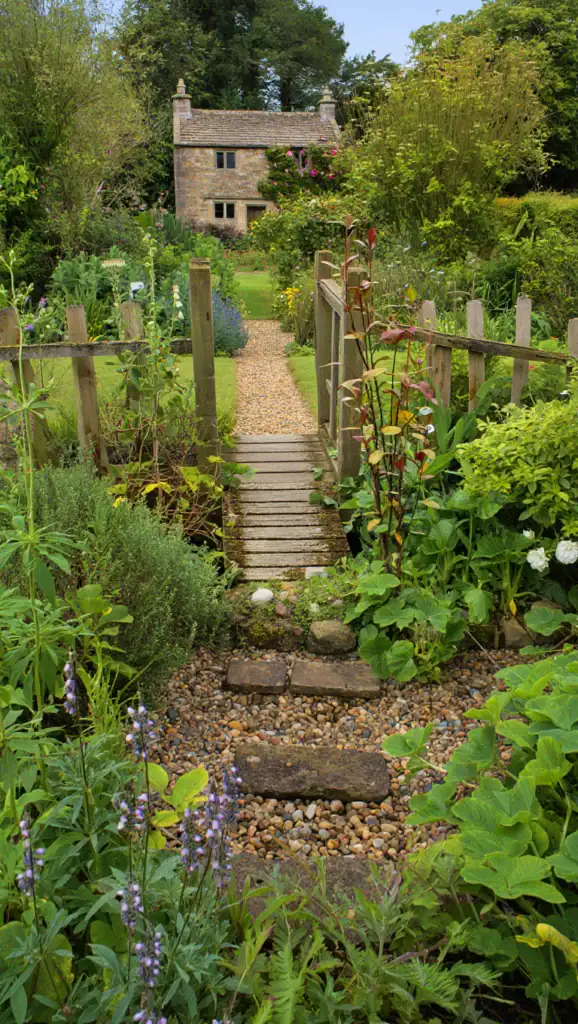
This garden feels like a quiet invitation to wander. A narrow gravel path flanked by wild herbs, lavender, and old-world perennials winds its way toward a timeless cottage. A wooden bridge crosses a shallow trench, marking the threshold from structured garden to meadow. This is storytelling in landscape form—layered, natural, and deeply nostalgic. To recreate, use pea gravel or crushed stone in varied grades and shape your path with gentle, asymmetrical curves. Plant informally along the edge: foxglove, lupine, oregano, feverfew, and blue sage all add height and charm. Let the lines blur. Let a bit of moss creep in. This path isn’t just a route—it’s a memory.
21. Jungle Zen Flow

This bold, tropical Zen garden reinterprets serenity through lush abundance. A sinuous, fine gravel path flows like a river through dramatic foliage—elephant ears, alocasia, philodendrons, and calatheas dominate with deep greens and rippled textures. Rounded architectural planters hold specimen ferns and banana trees, elevating key elements like pedestals. To recreate this look, start with contrast: rich, dark foliage against a light gravel base. Use curved edging to guide motion and create tension between softness and structure. Choose fewer species in greater quantity to avoid chaos—mass planting is your friend. This is a garden of movement, not noise. Every turn should feel deliberate, yet wild. It’s drama with discipline.
22. Rain Chain Cottage Dream

A copper rain chain guides the eye downward while a symphony of soft moss and flowering perennials surrounds a stone basin—proof that even practical elements can be poetic. The ivy-draped stone cottage in the distance anchors the romance of the scene, while cobblestone paths lend rustic permanence underfoot. To recreate this timeless setting, plant Japanese anemones, garden phlox, and delphinium in sweeping clusters, allowing them to mingle casually along the path’s edge. Aged brick or reclaimed cobblestone adds authenticity underfoot. Pair a decorative rain chain with a carved bowl or large stone saucer and let moss take over the base. The effect? A functional monsoon feature that becomes the garden’s beating heart.
23. Sculptural Ember Garden
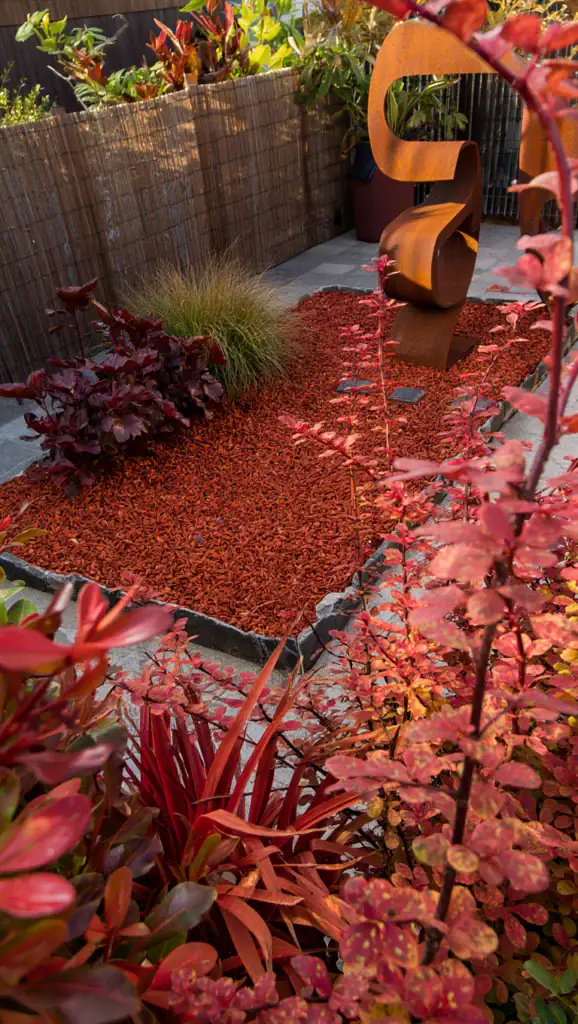
This fiery-toned courtyard blends sculptural form with blazing foliage for a bold Zen-inspired impact. A modern rusted metal form rises from a bed of crimson bark mulch, framed by smoky Cotinus, golden barberry, and red cordyline. The balance between sharp structure and layered texture creates a magnetic tension. To recreate the look, choose plants with foliage that echoes burnt orange, plum, and copper tones—think Physocarpus ‘Diabolo,’ Heuchera ‘Amber Waves,’ and red-tipped flax. Keep the ground level simple but saturated—dyed mulch or crushed brick works well. Introduce one central sculpture with clean lines and weight. This garden is not shy—it’s controlled chaos with artistic restraint.
24. Moss Floor Meditation Nook

An elevated wood platform tucked in a pocket of ferns and moss is your personal meditation room beneath the sky. This compact Zen garden thrives on restraint: muted colors, tactile contrasts, and a low, grounded profile. Use dark gravel or lava rock for the base and anchor with stepping stones that feel as though they’ve emerged over time. Plant ferns such as Dryopteris or Japanese painted fern, and nestle in cushion moss, Irish moss, or dwarf mondo grass for softness. The seating platform can be made of weathered cedar or teak, raised just slightly to hover over the terrain. This isn’t just a corner—it’s a pause.
25. Checkerboard of Life

Geometry meets greenery in this striking grid of wood, gravel, and moss. The checkerboard layout balances order and growth, giving equal voice to hardscape and planting. Mossy pockets cradle dwarf conifers, creeping thyme, and wild strawberry, while gravel pathways add clean contrast and visual breathing room. To recreate this effect, use pressure-treated wooden tiles or recycled planks alternated with river gravel. Let moss creep naturally or assist with a moss milkshake (a blend of buttermilk and moss fragments). Tuck in hardy groundcovers that stay low and dense. The layout invites exploration, but what it really offers is harmony through balance.
26. Wisteria Bonsai Passage

This pergola-framed walkway is a study in time and texture. Mature wisteria drapes above, spilling its lilac blooms in soft waterfalls of color and scent. Below, aged flagstone paths are flanked by potted bonsai—carefully sculpted and placed to echo the pergola’s rhythm. To recreate the feel, build a wooden arbor or pergola and train wisteria over time with patience and pruning. Underneath, use irregular flagstones spaced with moss or low thyme. Add bonsai in oversized, shallow pots—try dwarf juniper, black pine, or cotoneaster. This garden is built on slow craft and living sculpture. It doesn’t bloom all the time—but when it does, it becomes unforgettable.

